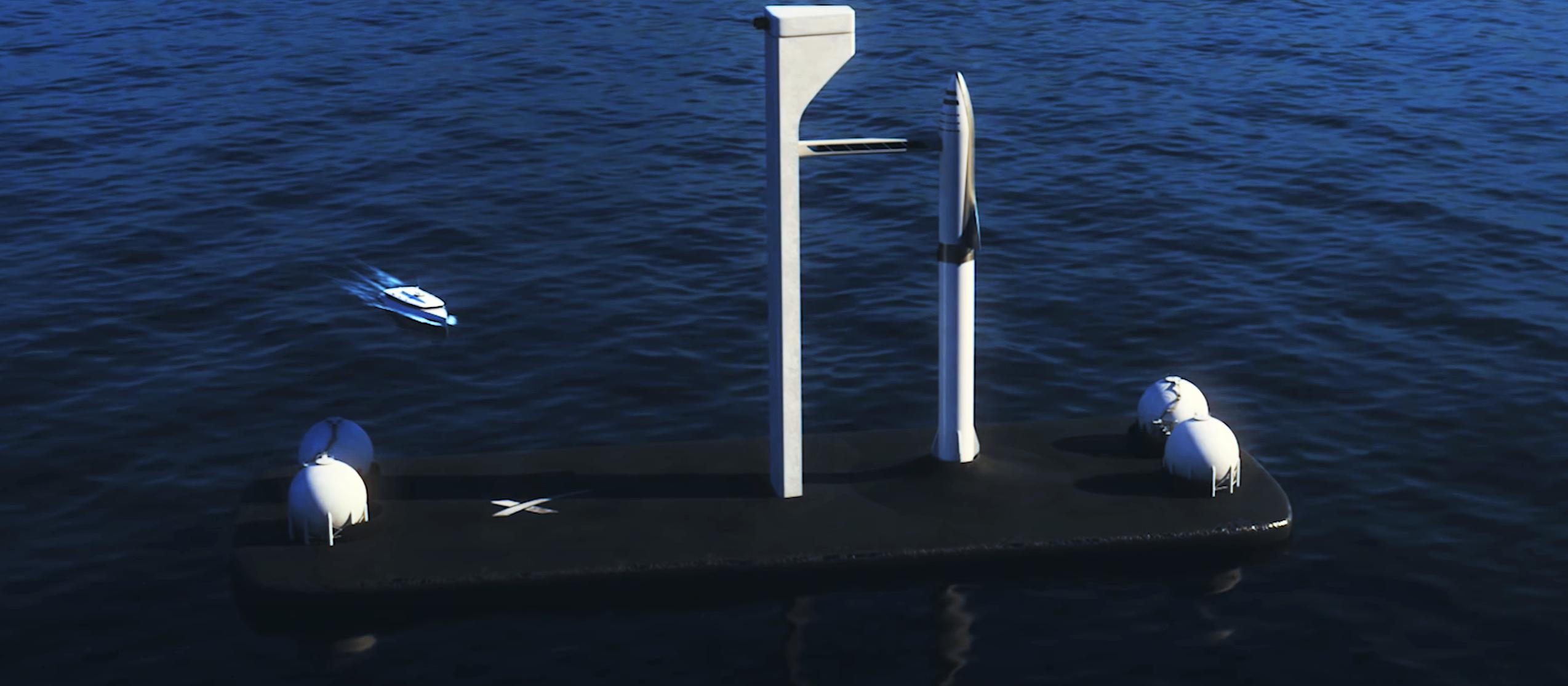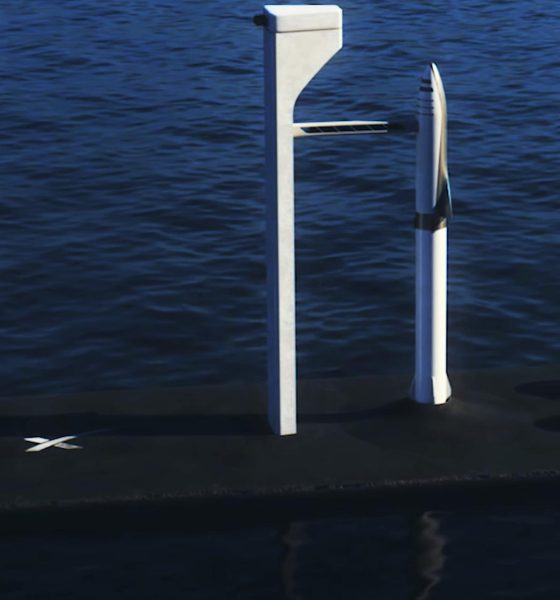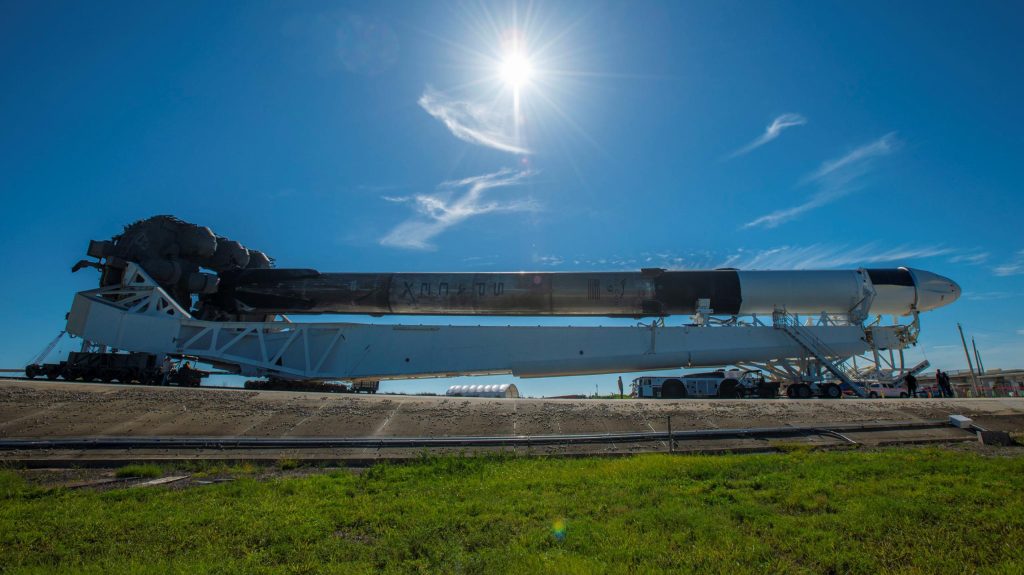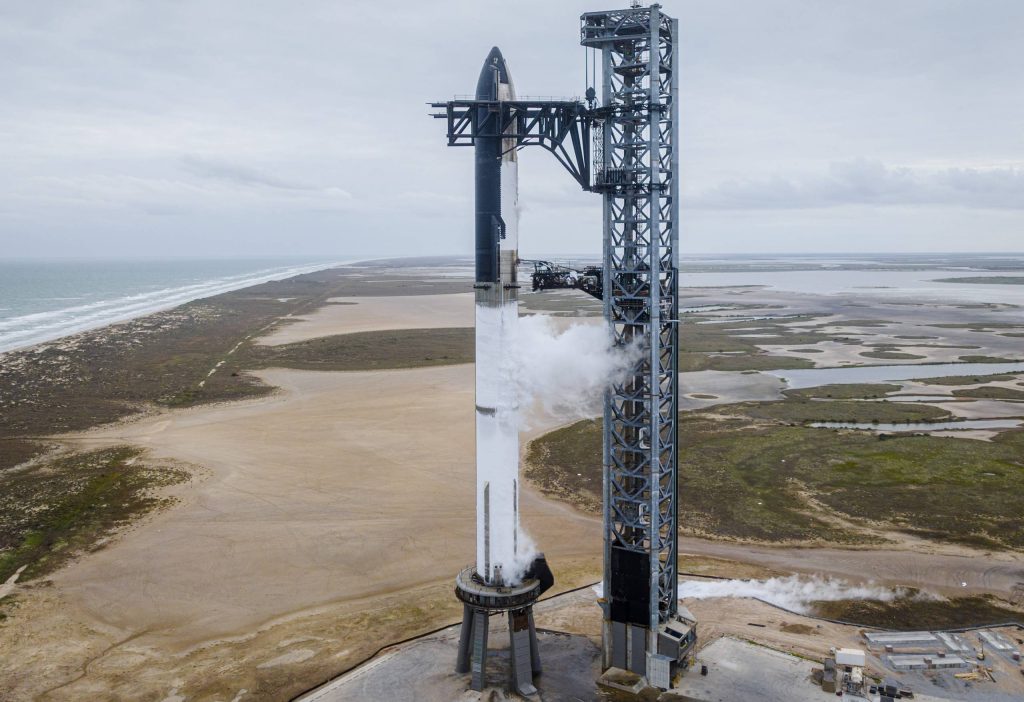

News
SpaceX prioritizes Starship test flights, pauses plans for floating launch pads
President and COO Gwynne Shotwell says that SpaceX has temporarily abandoned plans for floating Starship launch platforms to ensure it’s fully focused on gaining flight experience with the next-generation rocket.
On February 13th, a NASASpaceflight.com forum member reported that a pair of oil rigs were scheduled to leave a Mississippi port for an unknown destination. At one point, those oil rigs – christened Deimos and Phobos after Mars’ moons – were owned by SpaceX. In mid-2020, SpaceX bought the former half-billion-dollar oil rigs for just $7 million. Around the same time, CEO Elon Musk tweeted that SpaceX was “building floating, superheavy-class spaceports for Mars, moon & hypersonic travel around Earth.”
SpaceX’s oil rig purchase was publicly uncovered in January 2021. Since then, however, the company has done very little to Phobos or Deimos. Phobos’ deck was half-cleared in fitful bursts of work, but Deimos was left almost untouched. Now, according to SpaceNews, SpaceX’s second in command says the company sold Phobos and Deimos and has paused work on offshore Starship launch platforms.
The update that's rolling out to the fleet makes full use of the front and rear steering travel to minimize turning circle. In this case a reduction of 1.6 feet just over the air— Wes (@wmorrill3) April 16, 2024
In August 2021, Musk added some additional insight, revealing that the platforms were not a priority and that the only visible work done was the result of SpaceX hiring third parties to clear Phobos’ deck. Ultimately, the project may have been a false start. Speaking in February 2023, Shotwell told reporters that while SpaceX had sold the rigs, she was still confident that “sea-based [launch] platforms” would become a crucial asset in the future.
Perhaps even exceeding CEO Elon Musk’s infamously lofty ambitions, Shotwell said that SpaceX has “designed Starship to be as much like aircraft operations as we possibly can get” in the hopes of enabling “dozens of launches a day, if not hundreds of launches a day.” No rocket family in history has launched more than 61 times in one calendar year, making Shotwell’s Starship cadence target hundreds or even thousands of times more ambitious than a 1980s rocket record that’s still standing four decades later.
It’s unclear if the FAA’s stringent environmental reviews would ever allow SpaceX to get close to that kind of launch cadence using pads built on US soil. SpaceX fought long and hard to receive approval for up to five orbital Starship launches per year out of Boca Chica, Texas. SpaceX has also received approval [PDF] for up to 24 Starship launches per year out of a NASA Kennedy Space Center pad in Cape Canaveral, Florida. And SpaceX is permitted to launch [PDF] up to 70 much smaller Falcon rockets per year from its two existing Cape Canaveral pads.



“Dozens” to “hundreds” of Starship launches per day would be two or three orders of magnitude beyond the highest cadences the FAA has ever permitted. Shotwell’s continued interest in floating platforms is thus unsurprising, as they may be the only way SpaceX can realistically achieve airline-like Starship operations while still coexisting with US regulators.
According to SpaceNews, Shotwell said that SpaceX “really need[s] to fly [Starship] to understand it – to get to know this machine – and then we’ll figure out how we’re going to launch it.” That disciplined focus could be just the thing the Starship program needs. More than eighteen months after SpaceX first fully stacked a two-stage Starship, the rocket still hasn’t attempted an orbital launch. SpaceX has, nonetheless, put a vast amount of money and effort into building, expanding, and optimizing factories and launch facilities for Starship, an orbital rocket that has yet to even partially demonstrate itself.
In essence, SpaceX has made huge gambles on the assumption that a version of Starship mostly resembling what the company is building today will be highly successful, reusable, and reliable. SpaceX’s success with Falcon 9, Falcon Heavy, Dragon, and suborbital Starship testing suggests that it will ultimately be successful, in time. Nonetheless, Shotwell’s apparent desire to conduct orbital Starship launches and gather data before making major investments in new infrastructure (and, hopefully, big design changes and “optimizations”) is a welcome change of pace. Shotwell reportedly assumed oversight of Starbase and Starship in late 2022.

Elon Musk
Elon Musk’s X will start using a Tesla-like software update strategy
The initiative seems designed to accelerate updates to the social media platform, while maintaining maximum transparency.

Elon Musk’s social media platform X will adopt a Tesla-esque approach to software updates for its algorithm.
The initiative seems designed to accelerate updates to the social media platform, while maintaining maximum transparency.
X’s updates to its updates
As per Musk in a post on X, the social media company will be making a new algorithm to determine what organic and advertising posts are recommended to users. These updates would then be repeated every four weeks.
“We will make the new 𝕏 algorithm, including all code used to determine what organic and advertising posts are recommended to users, open source in 7 days. This will be repeated every 4 weeks, with comprehensive developer notes, to help you understand what changed,” Musk wrote in his post.
The initiative somewhat mirrors Tesla’s over-the-air update model, where vehicle software is regularly refined and pushed to users with detailed release notes. This should allow users to better understand the details of X’s every update and foster a healthy feedback loop for the social media platform.
xAI and X
X, formerly Twitter, has been acquired by Elon Musk’s artificial intelligence startup, xAI last year. Since then, xAI has seen a rapid rise in valuation. Following the company’s the company’s upsized $20 billion Series E funding round, estimates now suggest that xAI is worth tens about $230 to $235 billion. That’s several times larger than Tesla when Elon Musk received his controversial 2018 CEO Performance Award.
As per xAI, the Series E funding round attracted a diverse group of investors, including Valor Equity Partners, Stepstone Group, Fidelity Management & Research Company, Qatar Investment Authority, MGX, and Baron Capital Group, among others. Strategic partners NVIDIA and Cisco Investments also continued support for building the world’s largest GPU clusters.
News
Tesla FSD Supervised wins MotorTrend’s Best Driver Assistance Award
The decision marks a notable reversal for the publication from prior years, with judges citing major real-world improvements that pushed Tesla’s latest FSD software ahead of every competing ADAS system.

Tesla’s Full Self-Driving (Supervised) system has been named the best driver-assistance technology on the market, earning top honors at the 2026 MotorTrend Best Tech Awards.
The decision marks a notable reversal for the publication from prior years, with judges citing major real-world improvements that pushed Tesla’s latest FSD software ahead of every competing ADAS system. And it wasn’t even close.
MotorTrend reverses course
MotorTrend awarded Tesla FSD (Supervised) its 2026 Best Tech Driver Assistance title after extensive testing of the latest v14 software. The publication acknowledged that it had previously criticized earlier versions of FSD for erratic behavior and near-miss incidents, ultimately favoring rivals such as GM’s Super Cruise in earlier evaluations.
According to MotorTrend, the newest iteration of FSD resolved many of those shortcomings. Testers said v14 showed far smoother behavior in complex urban scenarios, including unprotected left turns, traffic circles, emergency vehicles, and dense city streets. While the system still requires constant driver supervision, judges concluded that no other advanced driver-assistance system currently matches its breadth of capability.
Unlike rival systems that rely on combinations of cameras, radar, lidar, and mapped highways, Tesla’s FSD operates using a camera-only approach and is capable of driving on city streets, rural roads, and freeways. MotorTrend stated that pure utility, the ability to handle nearly all road types, ultimately separated FSD from competitors like Ford BlueCruise, GM Super Cruise, and BMW’s Highway Assistant.
High cost and high capability
MotorTrend also addressed FSD’s pricing, which remains significantly higher than rival systems. Tesla currently charges $8,000 for a one-time purchase or $99 per month for a subscription, compared with far lower upfront and subscription costs from other automakers. The publication noted that the premium is justified given FSD’s unmatched scope and continuous software evolution.
Safety remained a central focus of the evaluation. While testers reported collision-free operation over thousands of miles, they noted ongoing concerns around FSD’s configurable driving modes, including options that allow aggressive driving and speeds beyond posted limits. MotorTrend emphasized that, like all Level 2 systems, FSD still depends on a fully attentive human driver at all times.
Despite those caveats, the publication concluded that Tesla’s rapid software progress fundamentally reshaped the competitive landscape. For drivers seeking the most capable hands-on driver-assistance system available today, MotorTrend concluded Tesla FSD (Supervised) now stands alone at the top.
News
Elon Musk’s Grokipedia surges to 5.6M articles, almost 79% of English Wikipedia
The explosive growth marks a major milestone for the AI-powered online encyclopedia, which was launched by Elon Musk’s xAI just months ago.

Elon Musk’s Grokipedia has grown to an impressive 5,615,201 articles as of today, closing in on 79% of the English Wikipedia’s current total of 7,119,376 articles.
The explosive growth marks a major milestone for the AI-powered online encyclopedia, which was launched by Elon Musk’s xAI just months ago. Needless to say, it would only be a matter of time before Grokipedia exceeds English Wikipedia in sheer volume.
Grokipedia’s rapid growth
xAI’s vision for Grokipedia emphasizes neutrality, while Grok’s reasoning capabilities allow for fast drafting and fact-checking. When Elon Musk announced the initiative in late September 2025, he noted that Grokipedia would be an improvement to Wikipedia because it would be designed to avoid bias.
At the time, Musk noted that Grokipedia “is a necessary step towards the xAI goal of understanding the Universe.”
Grokipedia was launched in late October, and while xAI was careful to list it only as Version 0.1 at the time, the online encyclopedia immediately earned praise. Wikipedia co-founder Larry Sanger highlighted the project’s innovative approach, noting how it leverages AI to fill knowledge gaps and enable rapid updates. Netizens also observed how Grokipedia tends to present articles in a more objective manner compared to Wikipedia, which is edited by humans.
Elon Musk’s ambitious plans
With 5,615,201 total articles, Grokipedia has now grown to almost 79% of English Wikipedia’s article base. This is incredibly quick, though Grokipedia remains text-only for now. xAI, for its part, has now updated the online encyclopedia’s iteration to v0.2.
Elon Musk has shared bold ideas for Grokipedia, including sending a record of the entire knowledge base to space as part of xAI’s mission to preserve and expand human understanding. At some point, Musk stated that Grokipedia will be renamed to Encyclopedia Galactica, and it will be sent to the cosmos.
“When Grokipedia is good enough (long way to go), we will change the name to Encyclopedia Galactica. It will be an open source distillation of all knowledge, including audio, images and video. Join xAI to help build the sci-fi version of the Library of Alexandria!” Musk wrote, adding in a later post that “Copies will be etched in stone and sent to the Moon, Mars and beyond. This time, it will not be lost.”








